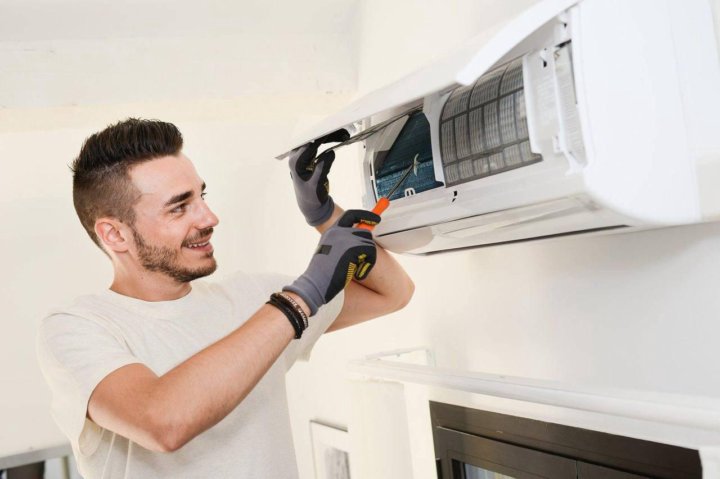Your air conditioner is one of the most important appliances in your Perth home—especially during the sweltering summer months. But like any mechanical system, it requires routine care to stay efficient and reliable. Ignoring warning signs can lead to emergency repairs, unexpected breakdowns, and higher energy bills. In this guide, we’ll walk you through the ten most common signs that your AC needs servicing—and why acting early can save you time, money, and discomfort.
1. Weak or Inconsistent Cooling
If your air conditioner isn’t delivering the same cool, steady airflow it once did—or it blows warm air when you expect chilly blow—this is a clear indicator that something is wrong. Common causes include:
Dirty filters or evaporator coils
Low refrigerant levels or refrigerant leaks
Failing compressor or fan issues
Serving your AC early ensures that cooling deficiencies are addressed before they become larger mechanical failures.
2. Strange Noises During Operation
While all AC units make some operational noise, unusual sounds like grinding, screeching, clanking, or loud clicking are warning signals. These noises often indicate:
Loose or damaged internal parts
Worn-out motor bearings
Debris inside the fan or compressor
Electrical issues
Delaying attention can result in a total mechanical failure—so get these sounds checked promptly.
3. Unpleasant or Foul Odours
If your system emits a musty, moldy, burning, or chemical smell, don’t ignore it. These scents typically suggest:
Mold or mildew growth inside ductwork or coils
Electrical burning or wiring problems
Refrigerant leaks or chemical contamination
Dead pests inside your system
A thorough inspection and cleaning—or in some cases, professional repair—is necessary to restore safety and comfort.
4. Frequent Cycling or Short Cycling
If your AC turns off and on rapidly or starts operating in short bursts, it may be short cycling. Possible reasons include:
Incorrect thermostat settings
Oversized or undersized unit for the space
Electrical or refrigerant system imbalance
Clogged filters or coils
Short cycling drives up energy consumption and increases stress on internal components.
5. Increased Energy Bills with Same Usage
If your power bills are trending upward, but your usage hasn’t changed significantly, it’s likely your AC is working harder than it should. This inefficiency often results from:
Clogged filters or heat-exchanging components
Refrigerant leak reducing overall performance
Worn-out or miscalibrated thermostats or sensors
Regular maintenance—even quick clean-ups—can restore efficiency and trim running costs.
6. Water Leaks or Condensation Around the Unit
While condensation is normal during operation, water pools or leaks around the indoor or outdoor unit are not. This can be caused by:
Blocked or disconnected condensate drainlines
Frozen evaporator coils
Sloped drain pan pointing in the wrong direction
If unchecked, water damage can affect ceilings, walls, and indoor air quality. Quickly addressing drain issues keeps moisture—and mould—at bay.
7. Visible Dirt, Dust, or Rust
A visual inspection can tell you a lot about your AC’s health:
Excessive dirt on filters, vents, or coils restricts airflow.
Rust on the outdoor condenser indicates potential corrosion damage.
Blocked fan grilles or debris build-up reduce performance and strain the motor.
Cleaning or replacing dirty components and protecting exposed parts helps maintain efficient airflow.
8. Weak Airflow from Vents
Even when the temperature is set low, weak airflow from vents points to a system blocked or damaged somewhere along the line. Possible causes:
Blocked ducts or internal vents
Dust-clogged filters
Failing blower motor
Leaks in the duct system
Weak airflow reduces cooling capacity and contributes to uneven room temperature. Periodic servicing restores proper airflow.
9. Thermostat Malfunctions or Inaccuracy
If your thermostat is refusing to respond, inaccurately reflecting indoor temperature, or causing inconsistent temperature control:
The sensor may be faulty or miscalibrated
The device may be wired incorrectly
Its placement in direct sunlight or near heat sources might impact its reading
Replacing or recalibrating a faulty thermostat can keep your system cycling properly and reduce unnecessary energy consumption.
10. Your AC Is Over 8–10 Years Old
Even well-maintained air conditioners age over time. If your system is entering its second decade and showing any of these warning signs repeatedly, it may be time to consider replacement rather than repeated repairs. Newer units offer improved:
Energy efficiency
Corrosion resistance
Smart features (like zoning and Wi-Fi control)
Manufacturer warranties
Proactive monitoring helps you avoid last-minute breakdowns during Perth’s hottest days.
Why Early Servicing Makes Sense
1. Cost Savings
A small tune-up or filter change is far less expensive than a full compressor replacement or emergency call-out fee.
2. Peace of Mind
You’ll avoid midseason breakdowns and stay comfortable throughout peak summer.
3. Warranty Protection
Many manufacturers require annual servicing to maintain warranty coverage—helping you when breakdowns occur unexpectedly.
4. Better Indoor Air Quality
Clean filters, coils, and ducts ensure improved airflow and reduce allergens, mold spores, and microbial contaminants.
5. Longer Equipment Life
Routine inspections and minor repairs can extend the lifespan of your system, delaying the need for full replacement.
DIY Checks vs. Professional Service
DIY (Safe for Homeowners)
Replace or clean air filters every 1–3 months.
Keep outdoor units free of leaves, dirt, and debris.
Test thermostat and control settings.
Regularly check for visible leaks or airflow issues.
Professional Service (Every Year or Pre-Season)
Clean evaporator and condenser coils.
Flush and sanitise the condensate drain line.
Inspect refrigerant levels and electrical connections.
Test for airflow, leakage, and safety compliance.
Lubricate motor parts and replace worn components.
How to Prepare for AC Servicing
Schedule Maintenance Early: Book at least a month before peak cooling season.
Clear Access: Provide a clear workspace for the technician.
List Issues: Note down any strange sounds, smells, or performance drops you’ve noticed.
Ask about Maintenance Records: Keep documentation for warranty purposes.
Check Credentials: Ensure technicians are licensed and insured.
Final Thoughts
Your air conditioner doesn’t usually fail the moment you need it most—it often gives signals leading up to a breakdown. Paying attention to warning signs like weak airflow, odd noises, or unexplained bills can help you act before a crisis hits.
Regular servicing, combined with timely repairs, ensures your home stays cool, your energy bills stay lower, and your air conditioning system lasts longer. If you’re in Perth and notice any of these signs, schedule service with a trusted provider like Aircool Care before your next heatwave.
Stay cool, stay informed—and let your AC work smarter, not harder.

